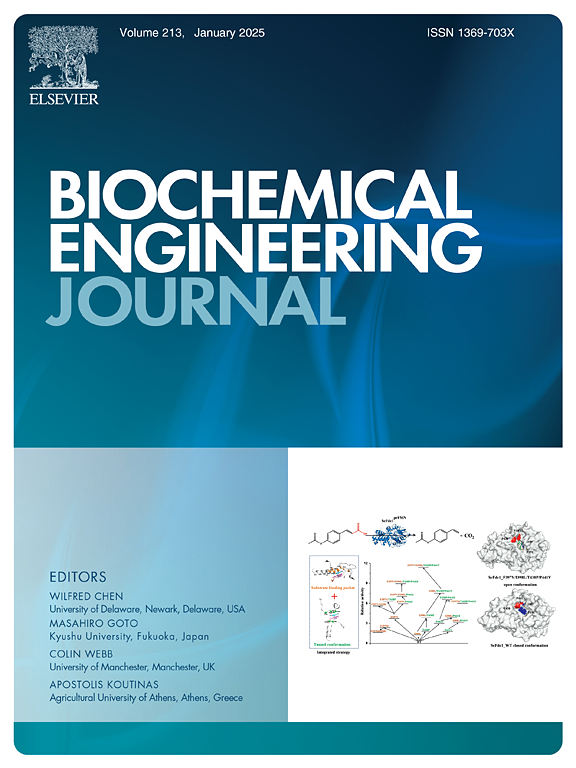一种新型生物工程蜘蛛丝为基础的化疗药物递送系统颗粒
IF 3.7
3区 生物学
Q2 BIOTECHNOLOGY & APPLIED MICROBIOLOGY
引用次数: 0
摘要
蜘蛛丝蛋白(spidroin)是蜘蛛丝纤维的主要成分,具有显著的生物相容性、热稳定性和可生物降解性,是一种很有前景的生物医学材料,特别是在药物输送方面。目前,利用蜘蛛蛛的药物输送系统主要集中在工程拖绳蜘蛛上。然而,对其他蜘蛛素类型的研究,如AcSp,在药物输送系统中作为生物材料的应用仍然非常有限。在这里,我们设计了重组蜘蛛蛋白AS2,来源于Araneus心室AcSp2蛋白重复结构域,并通过加入额外的谷氨酸残基设计了一个修饰版本eAS2。AS2和eAS2蛋白均表现出自组装特性,在磷酸钾缓冲液中形成二级结构含量相似的无毒纳米颗粒,但zeta电位值不同。虽然eAS2颗粒对带正电荷的药物如米托蒽醌(MTX)表现出很高的加载效率,但装载MTX的eAS2颗粒的释放速度也很快。相反,高效的负载和理想的缓释特性使得eAS2颗粒成为中性和带正电荷药物的最佳递送系统,如依托泊苷(ETP)和阿霉素(DOX)。本文章由计算机程序翻译,如有差异,请以英文原文为准。
A novel bioengineered spider silk-based particle for the delivery system of chemotherapy drugs
Spider silk protein (spidroin) is the primary constituent of spider silk fibers and exhibits remarkable biocompatibility, thermal stability, and biodegradability, making it a promising biomaterial for biomedical applications, particularly in drug delivery. Currently, drug delivery systems utilizing spidroins predominantly focus on engineered dragline spidroins. However, research on other spidroin types—such as aciniform spidroins (AcSp) —in their application as biomaterials within drug delivery systems remains very limited. Here, we engineered the recombinant spidroin AS2, derived from the Araneus ventricosus AcSp2 protein repeat domain, and designed a modified version, eAS2, by incorporating an additional glutamic acid residue. Both AS2 and eAS2 proteins exhibited self-assembly properties, forming non-toxic nanoparticles with similar secondary structure content in potassium phosphate buffer but differed in zeta potential values. Although eAS2 particles demonstrated high loading efficiency for positively charged drugs like mitoxantrone (MTX), a rapid release rate was also noted for MTX-loaded eAS2 particles. Conversely, the combination of efficient loading and a desirable slow release profile renders eAS2 particles an optimal delivery system for neutral and positive charged drugs, such as etoposide (ETP) and doxorubicin (DOX).
求助全文
通过发布文献求助,成功后即可免费获取论文全文。
去求助
来源期刊

Biochemical Engineering Journal
工程技术-工程:化工
CiteScore
7.10
自引率
5.10%
发文量
380
审稿时长
34 days
期刊介绍:
The Biochemical Engineering Journal aims to promote progress in the crucial chemical engineering aspects of the development of biological processes associated with everything from raw materials preparation to product recovery relevant to industries as diverse as medical/healthcare, industrial biotechnology, and environmental biotechnology.
The Journal welcomes full length original research papers, short communications, and review papers* in the following research fields:
Biocatalysis (enzyme or microbial) and biotransformations, including immobilized biocatalyst preparation and kinetics
Biosensors and Biodevices including biofabrication and novel fuel cell development
Bioseparations including scale-up and protein refolding/renaturation
Environmental Bioengineering including bioconversion, bioremediation, and microbial fuel cells
Bioreactor Systems including characterization, optimization and scale-up
Bioresources and Biorefinery Engineering including biomass conversion, biofuels, bioenergy, and optimization
Industrial Biotechnology including specialty chemicals, platform chemicals and neutraceuticals
Biomaterials and Tissue Engineering including bioartificial organs, cell encapsulation, and controlled release
Cell Culture Engineering (plant, animal or insect cells) including viral vectors, monoclonal antibodies, recombinant proteins, vaccines, and secondary metabolites
Cell Therapies and Stem Cells including pluripotent, mesenchymal and hematopoietic stem cells; immunotherapies; tissue-specific differentiation; and cryopreservation
Metabolic Engineering, Systems and Synthetic Biology including OMICS, bioinformatics, in silico biology, and metabolic flux analysis
Protein Engineering including enzyme engineering and directed evolution.
 求助内容:
求助内容: 应助结果提醒方式:
应助结果提醒方式:


